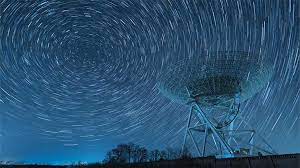Monitoring Desk
SYDNEY: The signals were unlike anything scientists had ever seen before: Radio wave circles, emanating from outer space, so huge that they could contain entire galaxies.
Detected in 2019 by the brand-new Australian Square Kilometer Array Pathfinder telescope, they stopped the observing scientists in their tracks: What were they? What caused them? They couldn’t answer.
But now, thanks to years of study, a team of physicists led by Alison Coil, a professor at the University of California San Diego, think they have a potential answer to part of the mystery of what they call “odd radio circles.”
In a paper published on Monday in Nature, the scientists lay out their theory: The radio wave circles are shockwaves that have traveled through the cosmos in the aftermath of massive stars exploding into supernovae —basically, a bomb blast of ultrafast, strong galactic winds.
The idea, Coil explained in a statement, is that when two large active galaxies collide, they can generate very intense, massive star formation.
As the massive stars burn out, they explode. If enough explode at roughly the same time, they push gas out the galaxy at phenomenal speeds — up to 1250 miles per second.
That gas is what generates the galactic winds, and that is what the astronomers saw in 2019.
Then, using further data collected at the W. M. Keck Observatory in Hawaii, they got the clues they needed to determine that at least one odd radio circle came from a galaxy that had seen a spate of massive star formation some 6 billion years ago.
These odd radio circles can span some ten times the size of the Milky Way.
“To make this work you need a high-mass outflow rate, meaning it’s ejecting a lot of material very quickly. And the surrounding gas just outside the galaxy has to be low density, otherwise the shock stalls. These are the two key factors,” Coil said in a statement.
“It turns out the galaxies we’ve been studying have these high-mass outflow rates. They’re rare, but they do exist.
I really do think this points to ORCs originating from some kind of outflowing galactic winds.”
Ultimately, this is just one of the many mysteries that cosmic radio signals pose for astronomers.
As we become better at listening to the universe, scientists are discovering more and more new phenomena — and some even hope that among the noise there could be communications from an extraterrestrial intelligence. But that’s not the case here, at least.
The discovery now provides a target for astronomers to focus their efforts on to solve this mystery: massive starburst galaxies, which have unusually high rates of star formation.
The theory builds on past research that suggested something cataclysmic had occurred inside a far-off galaxy to produce the shockwaves now rippling through the universe.







